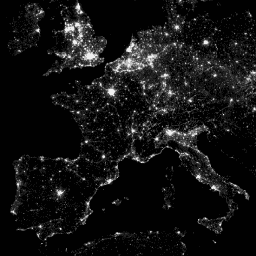
- در دسترس بودن مجموعه داده
- 1996-03-16T00:00:00Z–2011-07-31T00:00:00Z
- ارائه دهنده مجموعه داده
- گروه رصد زمین، موسسه پین برای سیاست عمومی، مدرسه معادن کلرادو
- برچسب ها
- کالیبره شده است
توضیحات
سیستم اسکن خط عملیاتی برنامه هواشناسی دفاعی (DMSP) (OLS) دارای قابلیت منحصر به فردی برای شناسایی منابع انتشار مرئی و مادون قرمز نزدیک (VNIR) در شب است.
این مجموعه شامل تصاویر نورهای شبانه جهانی بدون اشباع حسگر است. سنسور معمولاً در یک تنظیم با بهره بالا کار می کند تا امکان تشخیص ابرهای مهتابی را فراهم کند. با این حال، با کوانتیزاسیون شش بیتی و محدوده دینامیکی محدود، داده های ثبت شده در هسته های روشن مراکز شهری اشباع می شوند. مجموعه محدودی از مشاهدات در نور کم ماه به دست آمد که در آن بهره آشکارساز به طور قابل توجهی کمتر از تنظیمات عملیاتی معمولی آن (گاهی اوقات با ضریب 100) تنظیم شد. دادههای پراکنده بهدستآمده در تنظیمات کم بهره با دادههای عملیاتی بهدستآمده در تنظیمات با بهره بالا ترکیب شدند تا مجموعهای از تصاویر نورهای شبانه جهانی را بدون اشباع حسگر تولید کنند. دادههای ماهوارههای مختلف با هم ادغام و در محصول نهایی ترکیب شدند تا حداکثر پوشش را به دست آورند. برای اطلاعات بیشتر، این فایل readme ارائه دهنده را ببینید.
پردازش تصویر و داده توسط مرکز ملی داده ژئوفیزیک NOAA. داده های DMSP توسط آژانس هواشناسی نیروی هوایی ایالات متحده جمع آوری شده است.
باندها
اندازه پیکسل
927.67 متر
باندها
| نام | حداقل | حداکثر | اندازه پیکسل | توضیحات |
|---|---|---|---|---|
avg_vis | 0* | 6060.6* | متر | میانگین اعداد باند دیجیتال از مشاهدات با تشخیص نور بدون ابر. |
cf_cvg | 0* | 175* | متر | پوششهای بدون ابر، تعداد کل مشاهداتی که در هر سلول شبکه دوم 30 قوس انجام شده است. از این تصویر می توان برای شناسایی مناطقی با تعداد کم مشاهدات که در آنها کیفیت کاهش یافته است استفاده کرد. |
شرایط استفاده
شرایط استفاده
داده ها، اطلاعات و محصولات NOAA، صرف نظر از روش تحویل، مشمول حق چاپ نیستند و هیچ محدودیتی برای استفاده بعدی از آنها توسط عموم ندارند. پس از به دست آمدن، ممکن است از آنها استفاده قانونی شود. داده های فوق در حوزه عمومی است و بدون محدودیت در استفاده و توزیع ارائه می شود.
با Earth Engine کاوش کنید
ویرایشگر کد (جاوا اسکریپت)
var dataset = ee.ImageCollection('NOAA/DMSP-OLS/CALIBRATED_LIGHTS_V4') .filter(ee.Filter.date('2010-01-01', '2010-12-31')); var nighttimeLights = dataset.select('avg_vis'); var nighttimeLightsVis = { min: 3.0, max: 60.0, }; Map.setCenter(7.82, 49.1, 4); Map.addLayer(nighttimeLights, nighttimeLightsVis, 'Nighttime Lights');
